The Meizu PRO 6 Review
by Matt Humrick on August 26, 2016 8:00 AM EST- Posted in
- Smartphones
- Mobile
- MediaTek
- Meizu
- PRO 6
Battery Life
Our battery life tests cover a few common workloads and make it possible to compare the runtime potential of one phone to another. To make the tests accurate and repeatable, we control as many variables as possible, including minimizing background tasks and calibrating each display to 200 nits at 100% APL.
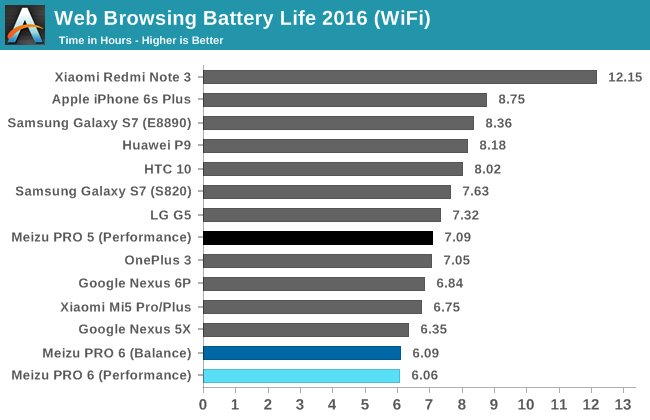
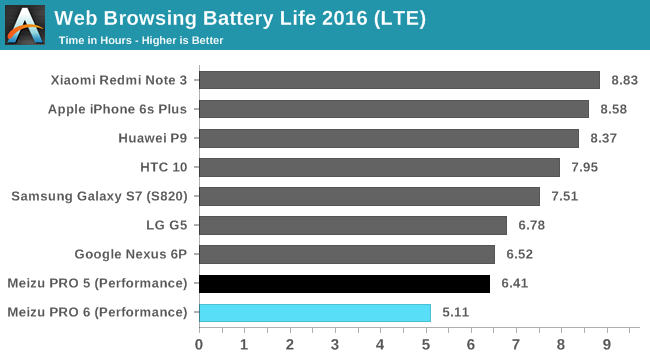
Our web browsing tests engage the CPU by pausing and then scrolling through each page after it’s loaded, and while the wireless radios consume some power too, display power draw continues to be the limiting factor in this workload.
The Meizu PRO 6 has a small battery. The average battery size for phones with 5.1-inch to 5.2-inch displays is about 3000mAh or 11.5Wh, which is 18% more than the PRO 6’s 2560mAh (9.73Wh) cell. It’s no surprise then to see it land at the bottom of the chart in our Wi-Fi browsing test, lasting just over 6 hours, a full 1 hour less than the PRO 5.
| Web Browsing Battery Life 2016 (WiFi): Average Platform Power (APP) | ||
| Phone | Display | APP (W) |
| Xiaomi Redmi Note 3 | 5.5-inch 1080p IPS LCD | 1.28 |
| Galaxy S7 (E8890) | 5.1-inch 1440p SAMOLED | 1.38 |
| Huawei P9 | 5.2-inch 1080p IPS LCD | 1.40 |
| Meizu PRO 6 | 5.2-inch 1080p SAMOLED | 1.61 |
| Meizu PRO 5 | 5.7-inch 1080p SAMOLED | 1.63 |
| Xiaomi Mi5 Pro | 5.15-inch 1080p IPS LCD | 1.72 |
Comparing average platform power (APP) numbers, a rough estimate of each phone’s average power consumption based on total runtime and battery capacity rather than an explicitly measured quantity, we see that both the Huawei P9 and Galaxy S7 (Exynos 8890), with similar size displays, consume about 13% less power than the PRO 6. It’s also interesting to see how close the APP is for the PRO 5 and PRO 6 when using their Performance modes (the PRO 5 drops to 1.54W in Balance mode) given the PRO 5’s larger display.
The PRO 6 loses 1 hour of runtime when switching to the cellular radio, with APP increasing 18% to 1.9W. Because the PRO 6, PRO 5, and Redmi Note 3 do not support US LTE frequency bands, they were forced to use WCDMA/HSPA+ instead, making direct comparisons to the other phones a bit more difficult; however, of these three phones the PRO 6 has the highest APP, followed by the PRO 5 and Redmi Note 3 both at 1.8W.
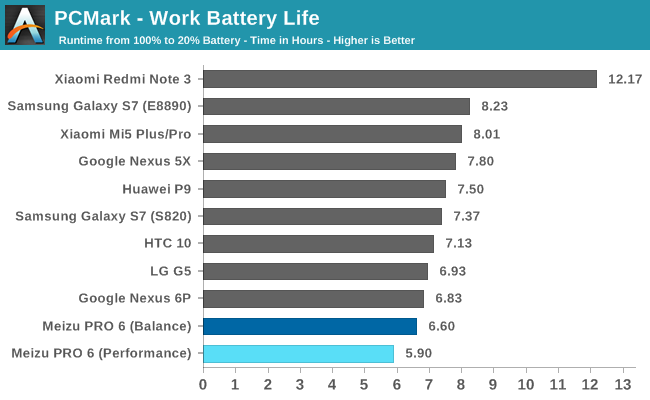
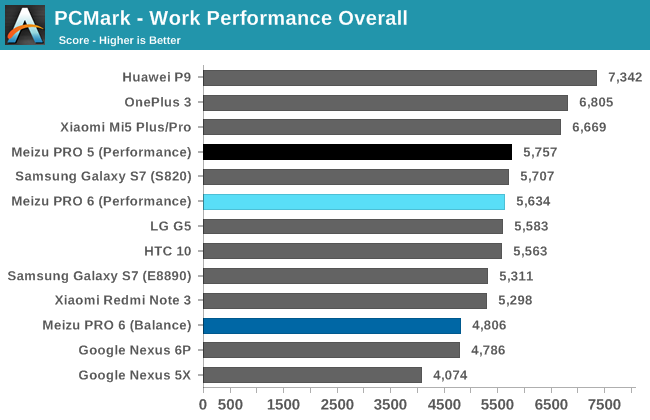
The PRO 6 and its small battery falls just shy of 6 hours using its Performance mode, hardly an impressive result when the Redmi Note 3 lasts twice as long and delivers nearly the same overall performance. The Huawei P9 outlasts the PRO 6 by almost an hour and delivers much better performance too. It’s a similar story with the Xiaomi Mi5: faster than the PRO 6 with almost 1.5 hours more battery life. The PRO 6 lasts 12% longer when using the Balance mode, basically putting it on par with the Nexus 6P.
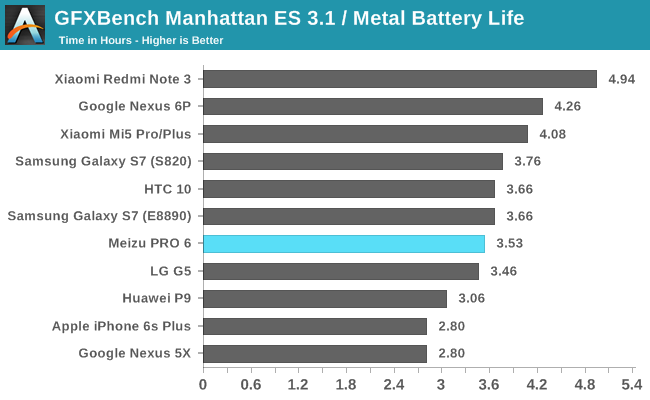
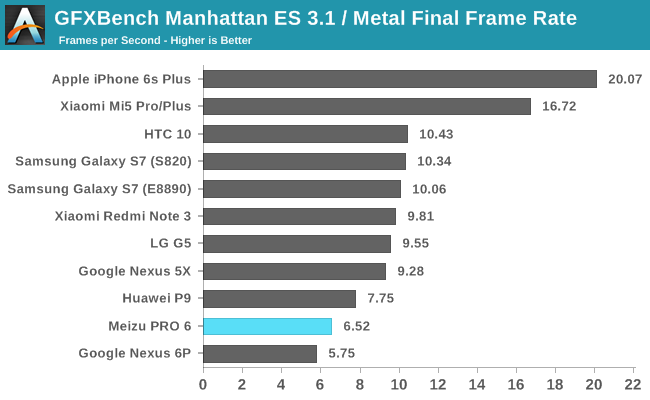
The PRO 6 lasts 3.5 hours in the GFXBench Manhattan 3.1 battery life test, which predicts runtime while playing games, an average result that’s diluted by poor performance. The Xiaomi Redmi Note 3, for example, lasts 1.4 hours longer and performs 50% faster at the end of the test. The Xiaomi Mi5 Pro lasts 33 minutes longer and is 2.5x faster. The PRO 6 does manage to outlast the Huawei P9, which has a larger battery and the same GPU, but it’s also 16% slower.
The GFXBench Manhattan 3.1 performance stability graph shows the PRO 6 can only maintain peak gaming performance for 15 minutes before it’s forced to reduce GPU frequency to avoid overheating. Frame rate reaches a relatively stable 7fps average after 30 minutes of gameplay. Thermal throttling reduces performance by 33% by the end of the test, a disappointing result for the Helio X25 SoC. The Huawei Mate 8, whose Kirin 950 SoC also uses a Mali-T880MP4 GPU, only drops 11% due to throttling, although it does have a larger frame to help dissipate heat.
3D Gaming Power Efficiency
The tables below quantify overall platform power efficiency while running 3D workloads. This should give us some additional insight into the PRO 6’s throttling behavior and battery life. The performance and power figures are averaged over the duration of each test, which last for approximately 1 minute. Before running the tests, we minimize background tasks, turn off all wireless radios, and calibrate the screens to 200 nits. Because of the short duration of the tests, these numbers represent the performance and power before any thermal throttling occurs.
Update 8/26/2016: The 3D power efficiency data has been updated to remove idle power consumption from the calculation.
| GFXBench Manhattan 3.1 Offscreen Power Efficiency (System Load Power) |
||||
| Mfc. Process | FPS | Avg. Power (W) |
Perf/W Efficiency |
|
| Galaxy S7 (Snapdragon 820) | 14LPP | 30.98 | 3.98 | 7.78 fps/W |
| Xiaomi Redmi Note 3 (Snapdragon 650) |
28HPm | 9.93 | 2.17 | 4.58 fps/W |
| Meizu PRO 6 (Helio X25) | 20Soc | 9.42 | 2.19 | 4.30 fps/W |
| Meizu PRO 5 (Exynos 7420) | 14LPE | 14.45 | 3.47 | 4.16 fps/W |
| Galaxy S6 (Exynos 7420) | 14LPE | 16.62 | 4.63 | 3.59 fps/W |
| Huawei P9 (Kirin 955) | 16FF+ | 10.59 | 2.98 | 3.55 fps/W |
The PRO 6 and its Helio X25 SoC uses the same or less power than the other phones in this comparison when running GFXBench Manhattan 3.1, despite using TSMC’s 20nm planar process. In the previous section we saw how the Mali-T760MP8 GPU in the Exynos 7420 delivers much better performance than the newer Mali-T880MP4 used in the Helio X25 and Kirin 955; however, this extra performance also requires more power, making the PRO 5 and Galaxy S6 a little less efficient than the PRO 6. It’s possible the T880’s architectural improvements partially offset the Exynos 7420’s process advantage here.
Another interesting point is that both the PRO 6 and Redmi Note 3 have the same average power consumption and nearly the same efficiency, but the PRO 6 experiences thermal throttling after looping through this test for 15 minutes while the Redmi Note 3 never throttles. Both phones get pretty warm, but the Redmi Note 3’s larger, thicker chassis and higher thermal mass seem to give it the edge in heat dissipation.
| GFXBench T-Rex Offscreen Power Efficiency (System Load Power) |
||||
| Mfc. Process | FPS | Avg. Power (W) |
Perf/W Efficiency |
|
| Galaxy S7 (Snapdragon 820) | 14LPP | 90.59 | 4.18 | 21.67 fps/W |
| Galaxy S7 (Exynos 8890) | 14LPP | 87.00 | 4.70 | 18.51 fps/W |
| Xiaomi Mi5 Pro (Snapdragon 820) | 14LPP | 91.00 | 5.03 | 18.20 fps/W |
| Apple iPhone 6s Plus (A9) [OpenGL] | 16FF+ | 79.40 | 4.91 | 16.14 fps/W |
| Xiaomi Redmi Note 3 (Snapdragon 650) |
28HPm | 34.43 | 2.26 | 15.23 fps/W |
| Meizu PRO 5 (Exynos 7420) | 14LPE | 55.67 | 3.83 | 14.54 fps/W |
| Xiaomi Mi Note Pro (Snapdragon 810 v2.1) |
20Soc | 57.60 | 4.40 | 13.11 fps/W |
| Galaxy S6 (Exynos 7420) | 14LPE | 58.07 | 4.79 | 12.12 fps/W |
| Meizu PRO 6 (Helio X25) | 20Soc | 32.46 | 2.84 | 11.43 fps/W |
| Huawei P9 (Kirin 955) | 16FF+ | 40.42 | 3.68 | 10.98 fps/W |
All of the phones see an increase in average power consumption when running GFXBench T-Rex. The Redmi Note 3 and its Adreno 510 GPU have the lowest power consumption of the group at 2.26W. The Snapdragon 820’s Adreno 530 GPU in the Galaxy S7 is the clear efficiency leader of the group, showing a 65% improvement over the Snapdragon 810 v2.1 in the Xiaomi Mi Note Pro we previously tested. The PRO 6’s efficiency is nearly the worst of the group when running T-Rex, although its average power consumption remains reasonable.
One of the points to take away from these two tables is that while an SoC’s manufacturing process plays a significant role in its power efficiency, it’s not the only factor to consider. Design decisions relating to CPU/GPU architecture and processor implementation details relating to trade offs between power and frequency or performance and area also play critical roles.
Battery Charging
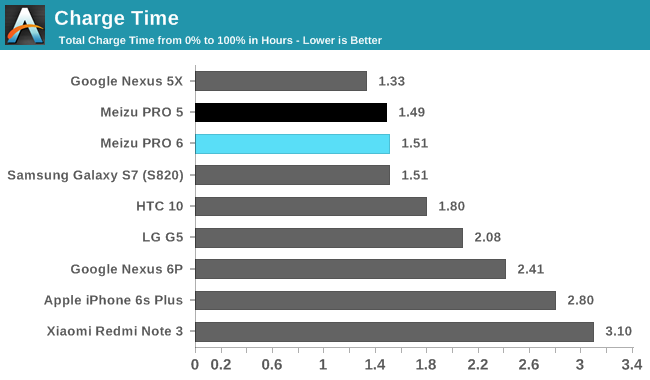
The PRO 6 includes Meizu’s mCharge 3.0 fast charging technology. This system incorporates Texas Instruments’ MaxCharge components, including the BQ25892 battery charger IC that implements battery temperature monitoring and overvoltage/overcurrent protections. The charger that comes with the PRO 6 is rated for 5V, 9V, or 12V operation at 2A for a theoretical maximum of 24W at the wall. I actually measured a peak of about 21W at the wall and 14W at the battery.
The PRO 6 charges at 14W for about 25 minutes before gradually reducing input power. At this rate, the PRO 6’s battery charges to 25% in 11 minutes and 50% in 22 minutes. It’s fully charged in 1.5 hours, the same as the Galaxy S7. It’s also the same time as the PRO 5, which has a 19% larger battery. The PRO 5 matches the PRO 6’s charge time by using a higher peak voltage of 17.4W. Because the PRO 5 uses a similar charging system, it appears Meizu is being a bit conservative with the PRO 6, calibrating the charging system to hit 1.5 hours rather than stressing the battery further to minimize charge time.
Like many phones with fast charging, the PRO 6 reduces input power when charging the phone with the screen turned on, dropping down to 12W at the wall, which translates to 7.3W at the battery.


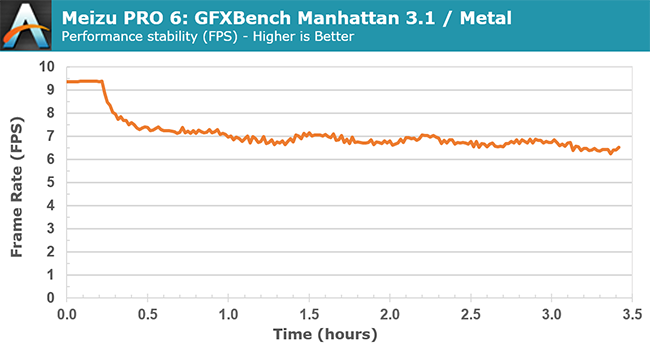









48 Comments
View All Comments
osxandwindows - Friday, August 26, 2016 - link
Where is the HTC10 review?arsjum - Friday, August 26, 2016 - link
All some of you guys do is complain. What is it about HTC 10 that you don't know yet? This to me is a much more interesting review, a different product.Besides, why don't you use Joshua's Twitter account to ask for an update instead of hijacking a different product's review section?
MrSpadge - Friday, August 26, 2016 - link
+1I'm really getting tired of all those guys asking (demanding?) a review of some other product. As if the current one was not worth talking about.
theduckofdeath - Monday, August 29, 2016 - link
I think it's fair to question a former great review site's inability to produce reviews lately. They do after all have comment sections to hear from the few readers they have left.Arnulf - Friday, August 26, 2016 - link
Hey, stop complaining!Notmyusualid - Saturday, August 27, 2016 - link
Hold on to your internet ladies!The guy is likely asking for the review, as Anandtech is THE place for smartphone reviews, and he is obviously interested in making said purchase.
Not too difficult to understand, no?
jtang97 - Sunday, August 28, 2016 - link
It's a valid question.The phone has been out for several months and still no review. Other newer phones have been released and reviewed and yet the HTC 10 review is still pending.
How are people supposed to make in informed choice on which phone to get when Anandtech doesn't release one of the better phones of 2016.
You've got all the benchmarks and photo/video comparisons and yet you still withhold releasing the review. Some people might start to think that you are paid to deliberately delay the review so that people will buy other phones instead of the HTC 10.
So. it is perfectly reasonable to ask about the HTC 10 review each time a newer phone is reviewed. There should be no reason the HTC 10 review is delayed by 3 months and counting.
Dennis Travis - Tuesday, August 30, 2016 - link
Where is the iPhone 3GS review? :D Grin I have been waiting for years for it! hahahahhahafanofanand - Wednesday, August 31, 2016 - link
Don't be silly, all Apple product reviews are copy and paste jobs from the last review. "Best ever, no reason to buy anything else" etc. ad nauseam.Fidelator - Wednesday, September 14, 2016 - link
I agree completely, I seriously feel they got paid off, the 10 is quite honestly a far more important and relevant product than say, this(no offense to Meizu). And quite possibly one of very best phones released this year and here we are waiting for their review.Now just wait for the review talking about how great was Apple's choice on killing the 3.5mm jack